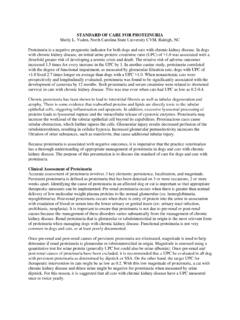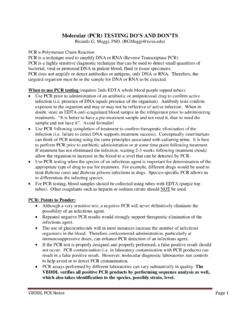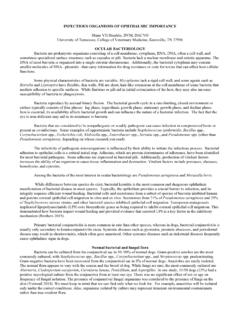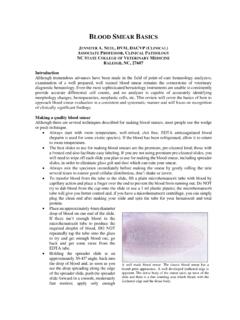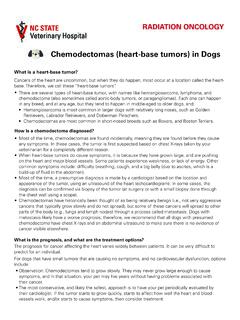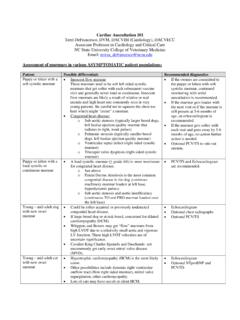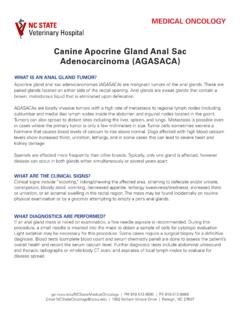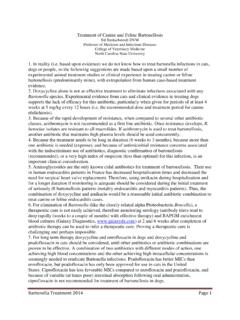Transcription of Canine Ehrlichiosis: Update - NC State Veterinary Medicine
1 Canine ehrlichiosis : Update Barbara Qurollo, MS, DVM Vector- borne disease Diagnostic Laboratory Dep. Clinical Sciences-College of Veterinary Medicine North Carolina State University Overview Ehrlichia species are tick-transmitted, obligate intracellular bacteria that can cause granulocytic or monocytic ehrlichiosis . Ehlrichia species that have been detected in the blood and tissues of clinically ill dogs in North America include Ehrlichia canis, E. chaffeenis, E. ewingii, E. muris and Panola Mountain Ehrlichia species (Table 1). Clinicopathologic abnormalities reported in dogs with ehrlichiosis vary depending on the species of Ehrlichia, strain variances and the immune or health status of the dog.
2 The course of disease may present as subclinical, acute, chronic or even result in death (Table 1). E. canis and E. ewingii are the most prevalent and frequently described Ehrlichia infections in dogs. E. canis: Transmitted by Rhipicephalus sanguineus, E. canis is found world-wide. Within North America, the highest seroprevalence rates have been reported in the Southern U. , 12 E. canis typically infects Canine mononuclear cells. Canine monocytic ehrlichiosis (CME) is characterized by 3 stages: acute, subclinical and chronic. Following an incubation period of 1-3 weeks, infected dogs may remain subclinical or present with nonspecific signs including fever, lethargy, lymphadenopathy, splenomegaly, lameness, edema, bleeding disorders and mucopurulent ocular discharge.
3 Less commonly reported nonspecific signs include vomiting, diarrhea, coughing and dyspnea. Bleeding disorders can include epistaxis, petechiae, ecchymoses, gingival bleeding and melena. Ocular abnormalities identified in E. canis infected dogs have included anterior uveitis, corneal opacity, retinal hemorrhage, hyphema, chorioretinal lesions and tortuous retinal Following an acute phase (2-4 weeks), clinical signs may resolve without treatment and the dog could remain subclinically infected indefinitely or naturally clear the pathogen. Some dogs, however, will go on to develop chronic CME.
4 It is still not clear why some dogs progress to the chronic phase, but possible reasons include co-infections, E. canis strain virulence, or the immune status of the dog. Some reports suggest a defective cell-mediated immune response may have a significant role in determining the course of German Shepherd dogs, Siberian Huskies and Belgium Malinoise develop the chronic form more commonly than other breeds. Dogs with chronic CME typically become bicytopenic or pancytopenic, developing anemia, thrombocytopenia and neutropenia due to E. canis-suppression of hematopoietic stem Dogs with acute CME can transiently develop a milder bicytopenia or pancytopenia.
5 Bone marrow cytology or histology in dogs with chronic CME (myelosuppression) will have a marked reduction in hematopoietic Lymphopenia or lymphocytosis may also be For dogs that survive chronic CME, it can take up to 6 8 months for cytopenias to fully resolve once E. canis has been cleared after treatment. Common symptoms of chronic CME include fever, anorexia, weight loss, depression, edema and more severe bleeding disorders. Secondary infections may occur due to neutropenia. Sequela of chronic CME may include arthritis, renal failure, interstitial pneumonia or Death can occur from hemorrhages or secondary infections.
6 Neurological signs, likely due to meningitis or cerebral hemorrhage, have occasionally been reported in acute and chronic CME including ataxia, seizures, cranial nerve deficits hyperesthesia, vestibular disease and E. chaffeensis: Transmitted by Amblyomma americanum, E. chaffeensis infects mononuclear cells and rarely causes clinical disease in naturally infected dogs. Fever and lethargy, along with mild thrombocytopenia and monocytosis has been , 14 20 E. ewingii: Transmitted by Amblyomma americanum, E. ewingii is the most seroprevalent Canine Ehrlichia spp.
7 In North America, predominantly in the Southern and Midwestern United States. 2, 12 It infects granulocytes, and clinicopathologic abnormalities reported in dogs with Canine granulocytic ehrlichiosis include fever, lameness, neurological abnormalities, lymphadenomegaly, peripheral edema, thrombocytopenia, leukopenia, and neutrophilic , 5,19 Conversely, several of these studies also reported naturally infected dogs with no clinical abnormalities. A recent study reported that dogs experimentally infected with E. ewingii after exposure to wild tick species in Oklahoma could be persistently PCR+ for up to two years and not develop overt clinical Persistent infection may occur when Ehrlichia spp.
8 Evade the host immune response through various mechanisms, including suppression of apoptosis and modulation of chemokine and cytokine Differences in clinical presentation in dogs infected with E. ewingii could be due to the immune status or health of the dog, the duration of infection or strain variances. It is possible E. ewingii may contribute to co-morbidities or function as a precipitating factor in a spectrum of clinical syndromes in dogs. A recent retrospective analysis of 32 dogs naturally infected with E. ewingii, without other vector- borne disease co-infections, identified limb and joint pain as the most frequently reported clinical finding, followed by heart murmur, gastrointestinal distress and Notable hematological and biochemical abnormalities included abnormal lymphocytosis, neutrophilia, anemia, elevated ALP and ALT, elevated creatinine, and hypoalbuminemia.
9 Urinalysis abnormalities included proteinuria Common diagnoses in this group of E. ewingii infected dogs included kidney disease and IMHA. E. muris: Little is known about E. muris infections in dogs. One case report describes an Anaplasma seropositive, E. muris PCR (+) dog that had been exposed to ticks , and presented with a fever, decreased activity, stiff gait and mild All Ehrlichia serology tests were negative (SNAP 4Dx and E. canis IFA). The dog was E. muris PCR (-) following treatment with doxycycline. E. muris is likely transmitted by Ixodes scapularis.
10 Panola Mountain Ehrlichia species (PME): Little is known about PME infections in dogs. PME was first identified by PCR in a goat experimentally infested with A. americanum ticks collected from Panola Mountain State Park, Georgia. One case report describes a PME PCR (+) dog with hepatomegaly, elevated ALT and ALP (the dog had a history of chronic hepatobiliary disease ), atypical lymphocytosis, clonal T-cell expansion and mild A population of abnormal lymphocytes in the liver and lymph node consistent with lymphoma was identified and flow cytometry revealed CD3+ cells, consistent with T-cell lymphoma.
